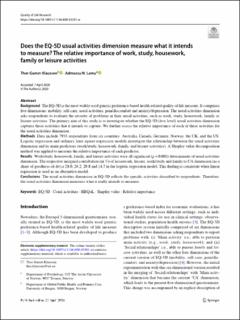| dc.description.abstract | Background
The EQ-5D is the most widely used generic preference-based health-related quality of life measure. It comprises five dimensions: mobility, self-care, usual activities, pain/discomfort and anxiety/depression. The usual activities dimension asks respondents to evaluate the severity of problems in their usual activities, such as work, study, housework, family or leisure activities. The primary aim of this study is to investigate whether the EQ-5D (five-level) usual activities dimension captures those activities that it intends to capture. We further assess the relative importance of each of these activities for the usual activities dimension.
Methods
Data include 7933 respondents from six countries: Australia, Canada, Germany, Norway, the UK, and the US. Logistic regression and ordinary least square regression models investigate the relationship between the usual activities dimension and its main predictors (work/study, housework, family, and leisure activities). A Shapley value decomposition method was applied to measure the relative importance of each predictor.
Results
Work/study, housework, family, and leisure activities were all significant (p < 0.001) determinants of usual activities dimension. The respective marginal contribution (in %) of housework, leisure, work/study and family to UA dimension (as a share of goodness-of-fit) is 28.0, 26.2, 20.8 and 14.7 in the logistic regression model. This finding is consistent when linear regression is used as an alternative model.
Conclusions
The usual activities dimension in EQ-5D reflects the specific activities described to respondents. Therefore, the usual activities dimension measures what it really intends to measure. | en_US |

